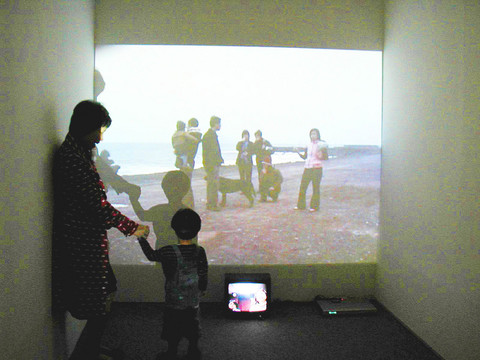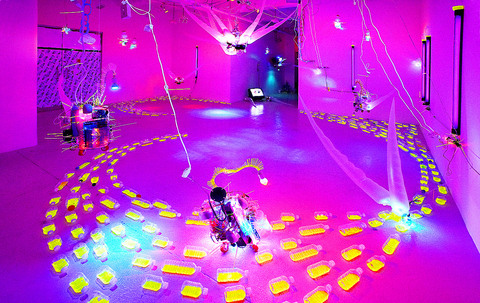Taiwan is not a utopia, or a dystopia. It's not a place. Diplomatically it has no space. Politically it does not exist. We can't even agree on its name.
Even so, its presence will be felt at the 52nd Venice Biennale in Italy next month, when six artists from the "nation without nationality" will be exhibiting their works.
The theme of the entry is Atopia and refers not only to the political position that Taiwan finds itself in, but also a 21st-century condition that applies to us all.

PHOTO: COURTESY OF ARTISTS
"Atopia refers to the situation of post-colonialism we are in. There has not been much time to become a country. Many other places are like this, nations without nationality," curator Hongjohn Lin (林宏璋) said yesterday at a press conference introducing Taiwan's Venice Biennale entry.
"Atopia" features work from the auteur Tsai Ming-liang (蔡明亮), photographer Lee Kuo-min (李國民), video director Tang Huang-chen (湯皇珍), bricoleur Huang Shih-chieh (黃世傑) and comic-book artist VIVA.
The range of artists chosen makes it a colorful as well as a challenging show that peers into the abyss to explore the concept of Taiwanese-ness.

PHOTO: COURTESY OF ARTISTS
Lin has borrowed the term atopia from the German sociologist Helmut Willke, who defines it as a non-place, or society without borders.
Globalization, multinational companies and the Internet are creating a world in which international markets, non-governmental organizations and multi-culturalism erase the relevance of nationhood.
Lin has adapted the term for his own purpose and localized it. The artist, academic and drummer said that Taiwan was an "atopian state par excellence."

PHOTO: COURTESY OF ARTISTS
It is not recognized as a state by most countries because of pressure from China, which claims it as its own. Even so, it has its own government and is a powerful economy.
Taiwan's identity is so amorphous it's name keeps changing, Lin said. When it competes in the Olympics it is called Chinese-Taipei. Officially it is the Republic of China, but this technically refers to the state formed in 1912 by Sun Yat-sen (孫逸仙), the "father of modern China."
Putting politics, sociology and names aside, Atopia captures the flavor of Taiwanese contemporary art in all its diversity.
Tsai Ming-liang's film installation Is It a Dream? is said to be "like a sculpture in time" and is set in a fading cinema in Malaysia, which refers to the golden age of flim and its current malaise. There is also a theme of displacement, which ties in with atopia.
Lee Kuo-min is a photographer who has documented disappearing lives, such as Treasure Hill and the Losheng Leprosarium, by taking pictures of people's living accommodation. They are intensely personal but also represent a contemporary reality.
Tang Huang-chen has explored the theme of personal memory in her video; while Huang Shih-chieh's bright technological inventions propose a vision of the future that is both humorous and slightly unsettling.
The comic artist VIVA explores the idea of copying other countries' culture and making it one's own. A series of cartoons (with translations by former Taipei Times reporter David Frazier) are memorable for their glocalized messages.
The Venice Biennale was first held in 1895 and is one of the world's major contemporary art exhibitions.
"Atopia" opens in the Taiwan Pavilion, at the Palazzo delle Prigioni in San Marco, Venice, Italy, from June 10 to Nov. 21. See www.labiennale.org.

Jan. 5 to Jan. 11 Of the more than 3,000km of sugar railway that once criss-crossed central and southern Taiwan, just 16.1km remain in operation today. By the time Dafydd Fell began photographing the network in earnest in 1994, it was already well past its heyday. The system had been significantly cut back, leaving behind abandoned stations, rusting rolling stock and crumbling facilities. This reduction continued during the five years of his documentation, adding urgency to his task. As passenger services had already ceased by then, Fell had to wait for the sugarcane harvest season each year, which typically ran from

It’s a good thing that 2025 is over. Yes, I fully expect we will look back on the year with nostalgia, once we have experienced this year and 2027. Traditionally at New Years much discourse is devoted to discussing what happened the previous year. Let’s have a look at what didn’t happen. Many bad things did not happen. The People’s Republic of China (PRC) did not attack Taiwan. We didn’t have a massive, destructive earthquake or drought. We didn’t have a major human pandemic. No widespread unemployment or other destructive social events. Nothing serious was done about Taiwan’s swelling birth rate catastrophe.

Words of the Year are not just interesting, they are telling. They are language and attitude barometers that measure what a country sees as important. The trending vocabulary around AI last year reveals a stark divergence in what each society notices and responds to the technological shift. For the Anglosphere it’s fatigue. For China it’s ambition. For Taiwan, it’s pragmatic vigilance. In Taiwan’s annual “representative character” vote, “recall” (罷) took the top spot with over 15,000 votes, followed closely by “scam” (詐). While “recall” speaks to the island’s partisan deadlock — a year defined by legislative recall campaigns and a public exhausted

In the 2010s, the Communist Party of China (CCP) began cracking down on Christian churches. Media reports said at the time that various versions of Protestant Christianity were likely the fastest growing religions in the People’s Republic of China (PRC). The crackdown was part of a campaign that in turn was part of a larger movement to bring religion under party control. For the Protestant churches, “the government’s aim has been to force all churches into the state-controlled organization,” according to a 2023 article in Christianity Today. That piece was centered on Wang Yi (王怡), the fiery, charismatic pastor of the